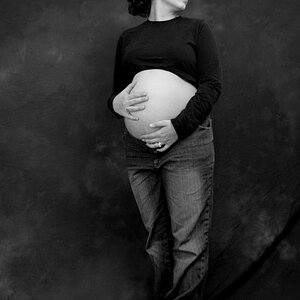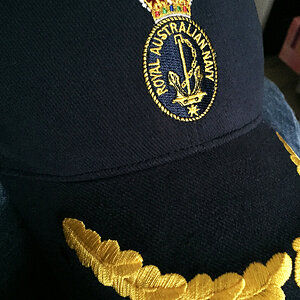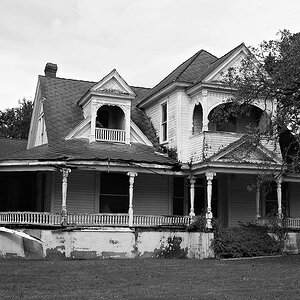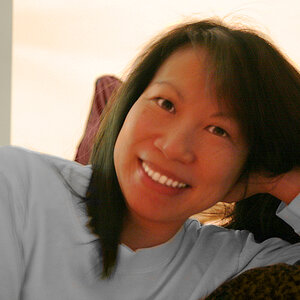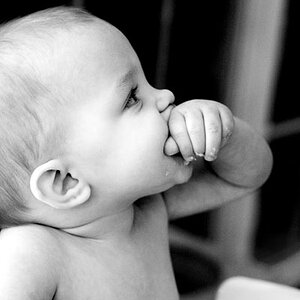Ysarex
Been spending a lot of time on here!
- Joined
- Nov 27, 2011
- Messages
- 7,139
- Reaction score
- 3,693
- Location
- St. Louis
- Can others edit my Photos
- Photos OK to edit
Hi All,
As many of you are aware I've taught photo at the college level for years. I've suffered with this problem for years now but it's getting worse as my students keep getting younger (yep, I know I'm the one not getting younger). Right now I have a group of first semester students in a beginning digital photo class. A little less than half of them have entry level DSLRs and the rest have various Coolpixs and Cybershots and Powershots and other assorted Crapshots.
Right now I have a group of first semester students in a beginning digital photo class. A little less than half of them have entry level DSLRs and the rest have various Coolpixs and Cybershots and Powershots and other assorted Crapshots.
I'm supposed to teach them how to use their cameras to best advantage, some design and composition basics, a little photo history, and some processing basics. The college supplies Photoshop in the lab and many of the students have software at home like Elements, iPhoto etc..
They've been taking landscape and cityscape photos over the past couple of weeks. My problem has to do with the processing basics part and their cameras. You'd think that one of the first things you'd teach a beginning photo student to do with their photos is to examine the histogram and evaluate it. Look for problems like clipped highlights for example and then learn to use that information to guide future control of the camera as well as suggest approaches for editing the photo at hand.
All of my students cameras SUCK! In fact my camera (5DmkII) sucks too in the very same way. Outside on blue-sky sunny days they all massively clip the blue channel. So one of my students, let's call her Emily, pays attention and goes out on a nice sunny day and takes a landscape photo front-lit with a clear blue sky. She gets a good exposure. She's been reading the book and knows enough now to look at a histogram in Photoshop and recognize what clipped highlights look like. She checks the histogram for her landscape and sees that her highlights are clipped to high heaven. (Pained look on her face) Emily asks, "what did I do wrong?"
What do I tell her? I look at her photo and see that the red and green channels are fine. I check the luminosity channel and it's compressed; if anything this photo is pretty flat and could use a contrast boost. And then there's that blue channel smashed up against the histogram right wall. The RGB composite channel takes the blue channel into account of course and so indicates badly clipped highlights.
I can show Emily the different color channels, but what's the explanation? And more importantly what do I tell her to do now? What to do next time she takes photos? What to do to process this photo?
An Example from my 5DmkII:
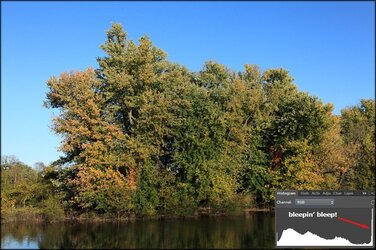
The inset histogram is the RGB composite and indicates clipped highlights. This is the JPEG the camera would have created. I used DPP to recreate it from the raw file. All the camera settings were at neutral when the photo was taken and I set a -.3 exp. comp. NOTE: The blue channel is massively clipped with a -.3 exp. comp. applied! Here's how badly the blue channel is clipped:
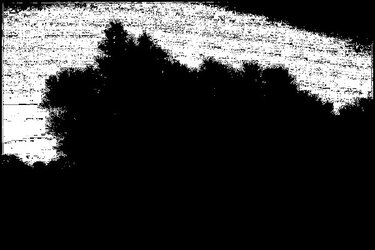
I did a threshold test of the blue channel. There's really nothing I could have done with the settings on the camera to avoid this at the time I took the photo. I reduced the saturation setting to the maximum and reprocessed the photo -- blue channel was better but still clipped and the rest of the photo looked sickly. So you can't tell me that appropriate settings in the camera will take care of this. Camera settings that would avoid clipping the blue channel would destroy the rest of the image.
Now this doesn't bother me personally because I have for a long time ignored camera processed photos and processing this photo from the raw file and not clipping the blue channel is quite easy to do. Went ahead and did that just to make sure this photo wasn't some strange special case:

So that wasn't hard, something I do almost daily. So then WHY CAN"T THE BLEEPIN' BLEEP CAMERAS DO IT?!!!
I can't tell Emily to just save raw files and learn to process them herself because her Coolpix, Cybershot, Powershot won't save raw files. Brittney has a new D3200 and I tried to say raw file to her -- that didn't go well, and because half the class has crapshot cameras I really have to deal with their camera processed photos.
So, the question again: What do I tell Emily?
I have dozens and dozens of student photos right now of blue-sky sunny day landscapes and cityscapes from my class and they have blown out blue channels. They're not bad exposures -- red and green channels are fine. A fair number of my students have learned to use the white balance presets and the color is pretty good, but the blue channels are clipped. A couple of my students have even gotten grey cards and set a custom white balance and the blue channels are clipped. Some of my students have shot brackets and even though they've set negative exp. comp factors the blue channels are clipped. These photos are not backlit, they're not even sidelit.
What do I tell Emily?
1. Don't worry you're doing OK it's just that your camera sucks.
2. Oh yeah I forgot to tell you, you can't include the sky when you take landscapes.
3. No you didn't do anything wrong, there's an exception to the clipped highlights rule -- blue skies.
4. Ashton was lying in that commercial you saw.
5. Camera image processors don't work very well, so yeah your camera sucks.
6. No you didn't do anything wrong and there's nothing you can change on the camera to make it work, you're just screwed.
7. Did you know that the earliest b&w films were excessively blue light sensitive and photographers like Henry Jackson had to take two exposures for landscapes; one for the sky and another for the foreground? Welcome to the past!
I could just try and ignore it and smile and say that's a nice picture, but Emily read the part of the book about the histogram and I've got to deal with her cognitive dissonance. It's getting harder and harder to explain to Emily that the software in her camera sucks and there's nothing much she can do about it (I'm not nearly as cute as Ashton). It's very frustrating and I feel like I'm less and less capable of giving them satisfactory answers. This younger generation doesn't seem to cope as well as earlier generations; they don't like peeking behind the curtain or being told their technology emperor isn't fully clothed.
Thanks for listening,
Joe
As many of you are aware I've taught photo at the college level for years. I've suffered with this problem for years now but it's getting worse as my students keep getting younger (yep, I know I'm the one not getting younger).
I'm supposed to teach them how to use their cameras to best advantage, some design and composition basics, a little photo history, and some processing basics. The college supplies Photoshop in the lab and many of the students have software at home like Elements, iPhoto etc..
They've been taking landscape and cityscape photos over the past couple of weeks. My problem has to do with the processing basics part and their cameras. You'd think that one of the first things you'd teach a beginning photo student to do with their photos is to examine the histogram and evaluate it. Look for problems like clipped highlights for example and then learn to use that information to guide future control of the camera as well as suggest approaches for editing the photo at hand.
All of my students cameras SUCK! In fact my camera (5DmkII) sucks too in the very same way. Outside on blue-sky sunny days they all massively clip the blue channel. So one of my students, let's call her Emily, pays attention and goes out on a nice sunny day and takes a landscape photo front-lit with a clear blue sky. She gets a good exposure. She's been reading the book and knows enough now to look at a histogram in Photoshop and recognize what clipped highlights look like. She checks the histogram for her landscape and sees that her highlights are clipped to high heaven. (Pained look on her face) Emily asks, "what did I do wrong?"
What do I tell her? I look at her photo and see that the red and green channels are fine. I check the luminosity channel and it's compressed; if anything this photo is pretty flat and could use a contrast boost. And then there's that blue channel smashed up against the histogram right wall. The RGB composite channel takes the blue channel into account of course and so indicates badly clipped highlights.
I can show Emily the different color channels, but what's the explanation? And more importantly what do I tell her to do now? What to do next time she takes photos? What to do to process this photo?
An Example from my 5DmkII:

The inset histogram is the RGB composite and indicates clipped highlights. This is the JPEG the camera would have created. I used DPP to recreate it from the raw file. All the camera settings were at neutral when the photo was taken and I set a -.3 exp. comp. NOTE: The blue channel is massively clipped with a -.3 exp. comp. applied! Here's how badly the blue channel is clipped:

I did a threshold test of the blue channel. There's really nothing I could have done with the settings on the camera to avoid this at the time I took the photo. I reduced the saturation setting to the maximum and reprocessed the photo -- blue channel was better but still clipped and the rest of the photo looked sickly. So you can't tell me that appropriate settings in the camera will take care of this. Camera settings that would avoid clipping the blue channel would destroy the rest of the image.
Now this doesn't bother me personally because I have for a long time ignored camera processed photos and processing this photo from the raw file and not clipping the blue channel is quite easy to do. Went ahead and did that just to make sure this photo wasn't some strange special case:

So that wasn't hard, something I do almost daily. So then WHY CAN"T THE BLEEPIN' BLEEP CAMERAS DO IT?!!!
I can't tell Emily to just save raw files and learn to process them herself because her Coolpix, Cybershot, Powershot won't save raw files. Brittney has a new D3200 and I tried to say raw file to her -- that didn't go well, and because half the class has crapshot cameras I really have to deal with their camera processed photos.
So, the question again: What do I tell Emily?
I have dozens and dozens of student photos right now of blue-sky sunny day landscapes and cityscapes from my class and they have blown out blue channels. They're not bad exposures -- red and green channels are fine. A fair number of my students have learned to use the white balance presets and the color is pretty good, but the blue channels are clipped. A couple of my students have even gotten grey cards and set a custom white balance and the blue channels are clipped. Some of my students have shot brackets and even though they've set negative exp. comp factors the blue channels are clipped. These photos are not backlit, they're not even sidelit.
What do I tell Emily?
1. Don't worry you're doing OK it's just that your camera sucks.
2. Oh yeah I forgot to tell you, you can't include the sky when you take landscapes.
3. No you didn't do anything wrong, there's an exception to the clipped highlights rule -- blue skies.
4. Ashton was lying in that commercial you saw.
5. Camera image processors don't work very well, so yeah your camera sucks.
6. No you didn't do anything wrong and there's nothing you can change on the camera to make it work, you're just screwed.
7. Did you know that the earliest b&w films were excessively blue light sensitive and photographers like Henry Jackson had to take two exposures for landscapes; one for the sky and another for the foreground? Welcome to the past!
I could just try and ignore it and smile and say that's a nice picture, but Emily read the part of the book about the histogram and I've got to deal with her cognitive dissonance. It's getting harder and harder to explain to Emily that the software in her camera sucks and there's nothing much she can do about it (I'm not nearly as cute as Ashton). It's very frustrating and I feel like I'm less and less capable of giving them satisfactory answers. This younger generation doesn't seem to cope as well as earlier generations; they don't like peeking behind the curtain or being told their technology emperor isn't fully clothed.
Thanks for listening,
Joe
Last edited:


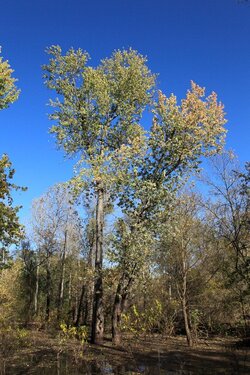

![[No title]](/data/xfmg/thumbnail/34/34073-71bff52a53b8313ff2bcccab6b05f9b8.jpg?1619736266)


